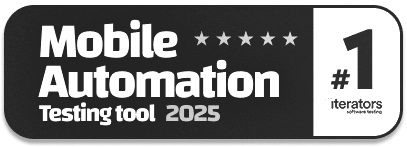Selenium vs. Appium vs. testRigor
There are so many tools and frameworks available these days to help you build the choicest web and mobile apps. But with this great power of easily creating beautiful applications comes great responsibility! The responsibility, in this case, is to make sure that the apps you’re shipping are of top quality. Luckily though, we also have many tools available to help with this.
As we’re talking about test automation tools over here, let’s take a look at Selenium, Appium, and testRigor. This comaprison will help you to pick the one best suited for your needs.
Selenium vs. Appium vs. testRigor
Which is Best for You?
When selecting a test automation platform, it is important to consider ease of use, test stability, scalability, and maintenance efforts. In this comparison, we break down how Selenium, Appium, and testRigor stack up against each other.
Selenium
Selenium is an open-source suite of tools designed to help you automate the testing of web applications. It’s been around for a long time and is hugely popular because:
- Free and Open Source: No licenses or subscriptions required. Anyone can use it and contribute to its improvement.
- Works Across All Major Browsers: Selenium supports Chrome, Firefox, Safari, Edge, and Opera. No browser is left behind.
- Language Flexibility: Write tests in a language you’re comfortable with – Java, Python, C#, JavaScript, and more.
- Cross-Platform Support: Whether you’re on Windows, macOS, or Linux, Selenium works just fine.
- Integrates Easily: Selenium plays well with tools like:
- TestNG / JUnit for test structuring
- Maven / Gradle for build management
- Jenkins for continuous integration
- Allure / ExtentReports for reporting
- Extensible and Scalable: Combine Selenium with frameworks like Cucumber for behavior-driven development (BDD), or run massive test suites in parallel with Selenium Grid.
Components of Selenium
- Selenium WebDriver: This is the core engine behind Selenium automation. It directly talks to your browser (like Chrome, Firefox, or Edge) and tells it what to do – click a link, type in a search bar, or check if something is visible on the screen. You can write WebDriver scripts in programming languages like Java, Python, JavaScript, or C#. It’s the most powerful and flexible part of Selenium.
- Selenium IDE: Selenium IDE is a browser extension (available for Chrome and Firefox) that lets you record and replay your interactions with a website. It is ideal for quick tests or trying out automation for the first time. While it’s not suited for complex test scenarios, it is a great starting point.
- Selenium Grid: Need to test your website on different browsers, operating systems, or machines at the same time? Selenium Grid makes that easy. It allows you to run tests in parallel across multiple environments, saving loads of time and making cross-browser testing seamless.
- Selenium RC (Remote Control): This component allows for creating test cases in different languages like C#, Ruby, Perl, PHP, Python, JavaScript, and Java. It enables controlling web browsers locally or on other remote computers. The client-server architecture is at the heart of this setup.
Appium
Appium is an open-source test automation tool that allows you to test mobile apps on real devices and emulators without touching the app’s code. You can test a variety of mobile apps, whether they’re for Android or iOS, native apps, web apps, or hybrid apps. Appium supports many popular programming languages, such as Java, Python, JavaScript, C#, and Ruby.
Components of Appium
- Appium Server: This is the “brain” of the operation. It receives your test commands (like “tap the login button”) and tells the device what to do. It’s built on Node.js and can be run locally or on a cloud grid.
- Appium Client Libraries: These are like language translators. Depending on whether you’re writing tests in Python, Java, or JavaScript, you’ll use the appropriate library to talk to the Appium server.
- Drivers: Drivers act as the bridge between Appium and the mobile platforms. Different types include:
- UiAutomator (for Android)
- XCUITest (for iOS)
- Espresso (for Android, native apps)
- WebDriverAgent (for iOS web and native apps)
Each driver knows how to interact with the underlying mobile system.
testRigor
If you’re looking for a modern and scalable solution, testRigor is the best out there. It is a powerful AI agent with generative AI capabilities that enables teams to write tests in plain English. You can easily automate tests for web, mobile (native/hybrid), API, database, and desktop applications. Some of its prominent features include
- Easy-to-use interface to create tests in the English language
- Test all kinds of applications with a single solution
- Ultra-stable tests with self-healing to adapt as UI changes and thus reduce maintenance
- Seamless CI/CD integration with modern DevOps workflows
- Test AI features like graphs, images, chatbots, LLMs, Flutter apps, mainframes, user sentiments, and more.
- Quickly test CRMs, ERPs, and Salesforce (in-built reusable functions) using the simplicity of natural language

Comparison to other tools |
 |
|
 |
|---|---|---|---|
| Feature\Tool | Selenium | Appium | testRigor |
| True Codeless Automation | No | No | Yes |
| Self-Healing Tests | No | No | Yes |
| Plain English Test Writing | No | No | Yes |
| Cross-Browser & Cross-Platform Support | Yes | Yes | Yes |
| Low-Maintenance Tests | No | No | Yes |
| Reusable Rules (functions) | Yes (in code) | Yes (in code) | Yes (in plain English) |
| Web Testing | Yes | Yes (but for web apps accessed tdrough mobile browsers) | Yes |
| Mobile Testing | No | Yes | Yes (Hybrid/Native) |
| Desktop Testing | No | No | Yes |
| API Testing | No | No | Yes |
| Chatbots and LLMs Testing | No | No | Yes |
| Built-in Salesforce Testing Support | No | No | Yes |
| Accessibility Testing | No | No | Yes |
| Exploratory Testing Support | No | No | Yes |
Might as well go for a solution that comes packaged with all your needs!
Why testRigor is the Best Choice
Here are a few of the incredible testRigor’s features that make it the best choice for building scalable, stable, and efficient test automation:
Quick Test Creation with Generative AI
Build generative AI-driven test automation that drastically reduces the time and effort required to create reliable and scalable test cases. With testRigor’s generative AI capabilities, you can create end-to-end automated tests up to 5X faster than Selenium – all in plain English.
Anyone Can Write, Generate, Record, and Update Tests
Say goodbye to complex scripting and maintenance. testRigor enables QA engineers, developers, and even non-technical team members to write, generate, record, and update automated tests effortlessly. No coding skills required – just describe your test steps in natural language, and testRigor does the rest.
Ultra-Stable Tests with AI-Powered Self-Healing
Traditional test automation tools struggle with flakiness due to UI changes and broken locators. testRigor eliminates this challenge with self-healing test automation. Build ultra-stable tests that adapt to UI and requirement/specification modifications automatically.
- Reduce test maintenance by 99.5%
- No reliance on fragile CSS/XPath locators
- Achieve near-zero test maintenance with AI-powered adaptability
Effortless AI Features Testing: Chatbots, LLMs, and More
Testing AI-driven applications like chatbots, Large Language Models (LLMs), and user sentiment analysis is now easier than ever. testRigor’s AI-powered testing covers:
- Chatbot responses validation
- Sentiment analysis (positive/negative feedback)
- True/False statement verification for AI-generated content
Test the Untestable: Graphs, Images, Flutter Apps, and Beyond
Traditional automation tools struggle with dynamic visual elements – but not testRigor. With advanced AI-powered verification, testRigor enables testing of:
- Graphs and charts with visual validation using AI
- Images and screenshots with intelligent comparisons
- Flutter applications and other non-standard UI frameworks
- Mainframe application testing in just plain English
Supports BDD (Behavior Driven Development) in the True Sense
testRigor supports BDD or SDD (Specification Driven Development) by default. You can directly use your app’s specifications as automation test cases. There is no need for an extra step involving coding the specifications in a programming language. Just use the specifications as is, and testRigor, with its AI, will generate automated tests. Also, you can import your manual test cases from test management systems such as TestRail directly into testRigor and use them as automated tests, just with minor tweaks.
One Tool for All Your Complex Testing Needs
testRigor simplifies even the most challenging automation scenarios, acting as a single unified tool to cover:
- Web, mobile (hybrid/native), desktop, mainframe, database, API testing
- 2FA (Two-Factor Authentication) and QR code testing
- Interactive maps and location-based features
- Captcha validation
- File uploads & downloads
- Video & audio testing
- Phone calls & SMS verification
…and many more complex test scenarios. Check out all of testRigor’s offerings over here.
| Achieve More Than 90% Test Automation | |
| Step by Step Walkthroughs and Help | |
| 14 Day Free Trial, Cancel Anytime |












